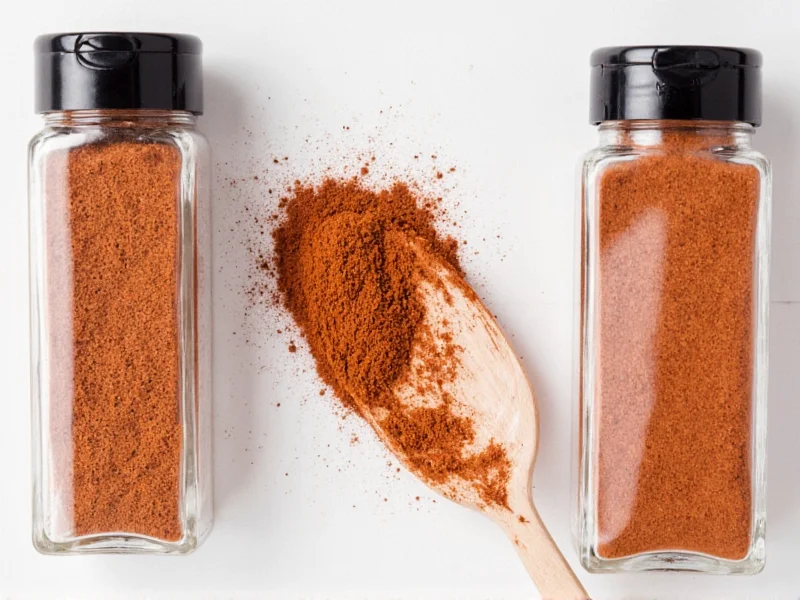When you're in the middle of cooking and realize you're out of Cajun seasoning, knowing reliable substitutes can save your dish. This guide provides practical solutions using common pantry ingredients, explains the flavor profile of authentic Cajun spice, and offers tailored substitutions for different cooking scenarios.
Understanding Cajun Spice Flavor Profile
Cajun seasoning isn't a single ingredient but a distinctive blend originating from Louisiana's Acadiana region. Unlike its milder Creole cousin, authentic Cajun spice features a bold, complex heat profile with earthy undertones. The traditional blend contains no cayenne-heavy punch but rather a balanced warmth from multiple pepper varieties.
Key components that define genuine Cajun seasoning include:
- Smoked paprika for earthy depth
- Garlic and onion for aromatic foundation
- Black pepper for sharp heat
- Cayenne for controlled spiciness
- Thyme and oregano for herbal complexity
- White pepper for distinctive warmth
Top Cajun Seasoning Substitute Options
Depending on your available ingredients and desired flavor intensity, several effective substitutions work well in most recipes. These alternatives maintain the essential flavor profile while accommodating common pantry limitations.
Pantry Staples Substitute (Most Accessible)
This quick Cajun spice replacement uses ingredients nearly every kitchen has on hand. It works particularly well for weeknight cooking when specialty spices aren't available.
| Ingredient | Measurement | Flavor Contribution |
|---|---|---|
| Paprika | 2 teaspoons | Earthy base, color |
| Garlic powder | 1 teaspoon | Aromatic foundation |
| Onion powder | 1 teaspoon | Savory depth |
| Black pepper | 1/2 teaspoon | Sharp heat |
| Cayenne pepper | 1/4-1/2 teaspoon | Controlled spiciness (adjust to taste) |
Enhanced Homemade Cajun Blend
When you have more specialty ingredients available, this closer approximation delivers restaurant-quality results. This Cajun seasoning alternative works particularly well for gumbo, jambalaya, and blackened fish.
Mix together:
- 2 tbsp smoked paprika
- 1 tbsp garlic powder
- 1 tbsp onion powder
- 1 tsp cayenne pepper
- 1 tsp dried thyme
- 1 tsp dried oregano
- 1 tsp black pepper
- 1/2 tsp white pepper
- 1/2 tsp salt (optional)
Store-Bought Cajun Spice Alternatives
If making your own blend isn't practical, several commercial products work as effective Cajun seasoning substitutes:
- Creole seasoning - Use at 1:1 ratio but reduce added salt in recipe
- Old Bay seasoning - Works well for seafood dishes (use 3/4 amount)
- Chipotle seasoning - Provides similar smokiness with different heat profile
- Adobo seasoning - Contains similar components but with more citrus notes
Adjusting Substitutes for Specific Dishes
Different recipes require tailored approaches when substituting Cajun spice. Understanding these nuances creates better results than using a one-size-fits-all approach.
For Seafood Dishes
When preparing shrimp, fish, or crawfish étouffée, reduce the cayenne by half and add 1/4 tsp celery seed. The celery adds authentic Louisiana flavor complexity that complements seafood beautifully.
For Poultry and Meat
When substituting Cajun seasoning in chicken, sausage, or pork recipes, increase the smoked paprika by 1/2 tsp and add 1/4 tsp mustard powder. This enhances the Maillard reaction during searing and creates better crust formation.
For Vegetarian and Vegan Dishes
Plant-based recipes benefit from adding 1/4 tsp mushroom powder to your Cajun spice substitute. This mimics the umami depth that traditionally comes from meat-based stocks in Cajun cooking.
Common Substitution Mistakes to Avoid
Even experienced cooks make these errors when creating Cajun seasoning alternatives:
- Over-relying on cayenne - Authentic Cajun heat comes from multiple pepper varieties, not just cayenne
- Skipping the thyme - This herb provides essential herbal complexity often missing in substitutes
- Using sweet paprika instead of smoked - The smokiness is crucial to authentic flavor
- Adding liquid ingredients - Substitutes should maintain dry consistency for proper application
- Not adjusting salt content - Many substitutes contain salt while others don't
Storage and Usage Tips
Homemade Cajun spice substitutes maintain best flavor when stored in airtight containers away from light. Properly stored, your DIY Cajun seasoning alternative will stay fresh for 4-6 months. For optimal flavor release, add the seasoning during the last 5-10 minutes of cooking rather than at the beginning.
Creating Regional Variations
Authentic Cajun cooking varies across Louisiana regions. You can customize your Cajun spice substitute to match specific regional profiles:
- Acadiana region style - Increase black pepper, reduce cayenne
- New Orleans style - Add 1/4 tsp celery salt and more oregano
- Bayou country style - Include 1/8 tsp ground allspice for complexity











 浙公网安备
33010002000092号
浙公网安备
33010002000092号 浙B2-20120091-4
浙B2-20120091-4